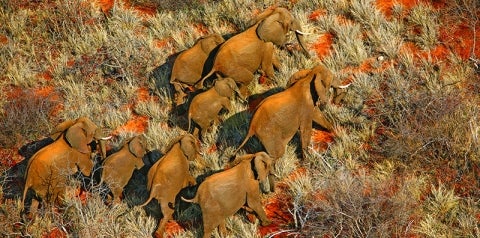Note: Yale School of the Environment (YSE) was formerly known as the Yale School of Forestry & Environmental Studies (F&ES). News articles and events posted prior to July 1, 2020 refer to the School's name at that time.
 <div> Aerial photo of migrating elephant herd</div>
<div> Aerial photo of migrating elephant herd</div>
One of the scientific tools being considered to reduce the impacts of climate change is solar geoengineering, or the injection of aerosols into the atmosphere to reflect sunlight back into space. But while the climate response to the technology has been studied extensively, less is known about how it would impact animal and plant species.
A new study, co-authored by a Yale scientist, finds that starting or halting such schemes too quickly could imperial most groups of animals.
According to the findings, published this week in the journal Nature Ecology & Evolution, a rapid implementation or termination of geoengineering projects could affect the rate of climate change so fast that most species wouldn’t be able to move fast enough to keep up with the changes.
A new study, co-authored by a Yale scientist, finds that starting or halting such schemes too quickly could imperial most groups of animals.
According to the findings, published this week in the journal Nature Ecology & Evolution, a rapid implementation or termination of geoengineering projects could affect the rate of climate change so fast that most species wouldn’t be able to move fast enough to keep up with the changes.
While we are currently modeling the potential effects of geoengineering, these models may not take into account the variability and complexities of these potential effects.
“While we are currently studying and modeling the potential effects of geoengineering, these models may not take into account the variability and complexities of these potential effects,” said Giuseppe Amatulli, a research scientist in geo-computation and spatial science at the Yale School of Forestry & Environmental Studies and co-author of the study.
Amatulli, a forest scientist and spatial modeler, is also affiliated with the Yale Center for Research Computing and the Center for Science and Social Science Information.
The research was led by Christopher Trisos, an ecologist at the University of Maryland’s National Socio-Environmental Synthesis Center.
Using the Yale Center for Research Computing’s supercomputing technologies, the scientists calculated how temperatures would change if 5 million tons of sulphur dioxide were injected into the stratosphere annually from 2020 to 2070. (That’s about one-quarter the aerosols emitted by the Mount Pinatubo volcanic eruption in 1991, which cooled the planet by 0.5 degrees C over two years.)
According to their analysis, the climate would cool quickly immediately after solar geoengineering started, as the climate system adjusted to less incoming solar radiation. But if for whatever reason humankind were to lose the will or means to continue geoengineering, they said, a sudden termination would cause rapid warming with a projected average speed of 10 kilometers per year on land, three times faster than climate change without solar geoengineering.
Amatulli, a forest scientist and spatial modeler, is also affiliated with the Yale Center for Research Computing and the Center for Science and Social Science Information.
The research was led by Christopher Trisos, an ecologist at the University of Maryland’s National Socio-Environmental Synthesis Center.
Using the Yale Center for Research Computing’s supercomputing technologies, the scientists calculated how temperatures would change if 5 million tons of sulphur dioxide were injected into the stratosphere annually from 2020 to 2070. (That’s about one-quarter the aerosols emitted by the Mount Pinatubo volcanic eruption in 1991, which cooled the planet by 0.5 degrees C over two years.)
According to their analysis, the climate would cool quickly immediately after solar geoengineering started, as the climate system adjusted to less incoming solar radiation. But if for whatever reason humankind were to lose the will or means to continue geoengineering, they said, a sudden termination would cause rapid warming with a projected average speed of 10 kilometers per year on land, three times faster than climate change without solar geoengineering.
The list of potential unintended ecological consequences from geoengineering is long, and we’ve only just scratched the surface.
This, the scientists predict, could spell disaster for many animals and ecosystems. “The list of potential unintended ecological consequences from geoengineering is long, and we’ve only just scratched the surface,” said Trisos.
Added Amatulli: “Any potential error can be extremely unpredictable, as well. Therefore, strong and effective regulations on emissions reduction with involvement of personnel at all levels remains the most important alternative currently for reducing carbon emission.”
For this research Amatulli implemented a scripting procedure using open source codes to allow full reproducibility of the research. The complete analyses, he said, can be used to conduct other related research, such as the potential consequences to agricultural productivity or on the urban heat island phenomenon.
RELATED: Geongineering Could Have Animals Running for their Lives
The original paper:
Added Amatulli: “Any potential error can be extremely unpredictable, as well. Therefore, strong and effective regulations on emissions reduction with involvement of personnel at all levels remains the most important alternative currently for reducing carbon emission.”
For this research Amatulli implemented a scripting procedure using open source codes to allow full reproducibility of the research. The complete analyses, he said, can be used to conduct other related research, such as the potential consequences to agricultural productivity or on the urban heat island phenomenon.
RELATED: Geongineering Could Have Animals Running for their Lives
The original paper:
Trisos, Christopher H.; Amatulli, Giuseppe; Gurevitch, Jessica; Robock, Alan; Xia, Lili; and Zambri Brian. 2018. “Potentially dangerous consequences for biodiversity of solar geoengineering implementation and termination.” Nature Ecology & Evolution.10.1038/s41559-017-0431-0
– Kevin Dennehy kevin.dennehy@yale.edu 203 436-4842
Published
January 22, 2018